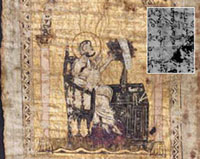
An early transcription of Archimedes' mathematical theories has been brought to light through the probing of high-intensity x-rays at SSRL's BL6-2. The text contains part of the Method of Mechanical Theorems, one of Archimedes' most important works, which was probably copied out by a scribe in the tenth century. The parchment on which it was written was later scraped down and reused as pages in a twelfth century prayer book, producing a document known as a palimpsest (which comes from the Greek, meaning 'rubbed smooth again'). Some of the text has been read previously, using everything from magnifying glasses to ultraviolet light, which highlights the hidden ink. Some of the text has been solidly obscured by some twentieth-century forgeries of medieval art that were slapped on top of a few pages. Working with curators at the Walters Art Museum and collaborators at Stanford University, SSRL staff scientist Uwe Bergmann suggested using synchrotron x-rays to peer through the forgeries. When hit by the x-rays the iron pigment in the original ink fluoresced and allowed researchers to see the text for the first time. Additional information on the Archimedes palimpsest and how x-rays read medieval ink can be found in the May 20 edition of the SLAC Interaction Point at:
http://www2.slac.stanford.edu/tip/2005/may20/archimedes.htm
August 2006 Press Coverage
Television
Radio
International Press
- X-rays Reveal Archimedes Secrets, Jonathan Fildes, BBC News (This story was the most popular story on the BBC site, on Thursday it was listed as the most popular story of the past five days - though only live for two days.) This article can also be found on the Turkish Weekly website
-
Eureka! Ancient Works by Archimedes Rediscovered, Geneviève Roberts, The Independent
Also published in the following:
Irish Independent Unison.ie - Eureka! X-ray Vision Helps Decipher Archimedes's Words of Wisdom, Roger Highfield, The Daily Telegraph Also published in the New York Sun
- X-Rays Illuminate Archimedes Writings, United Press International Though headquartered in the US, UPI's article was found at the following international sites: DailyIndia.com: http://www.dailyindia.com/show/48286.php/X-rays-illuminate-Archimedes-wr... North Korea Times: http://story.northkoreatimes.com/p.x/ct/9/cid/dd8845aa60952db2/id/6b975c... In addition, it can be found here: Monsters and Critics (US): http://science.monstersandcritics.com/news/article_1186808.php/Health_an... Political Gateway (US): http://www.politicalgateway.com/news/read/28466 Rayos X para Arquímedes, Helena Cebrian, El Pais http://www.elpais.es/articulo/sociedad/Rayos/X/Arquimedes/elpporsoc/2006...
Local/National Press
-
Prayer Book Reveals Secrets, Ian Hoffman, San Mateo County Times http://www.insidebayarea.com/sanmateocountytimes/localnews/ci_4124688
The article can also be found here:
Mercury Register: http://www.orovillemr.com/news/bayarea/ci_4124752
Inside Bay Area: http://www.insidebayarea.com/localnews/ci_4124752
Oakland Tribune: http://www.insidebayarea.com/oaklandtribune/ci_4124752
Alameda Times Star: http://www.insidebayarea.com/timesstar/ci_4124752 -
Revealing Secrets of Archimedes, Lisa Krieger, San Jose Mercury News
http://www.mercurynews.com/mld/mercurynews/living/15187435.htm
The article was the top feature on the Mercury News home page, the top story on the online News page and was the front cover story of the Peninsula section of the SJ Mercury's print edition.The article can be found on the following sites:
Silicon Valley: http://www.siliconvalley.com/mld/siliconvalley/news/15188980.htm
Kentucky.com: http://www.kentucky.com/mld/kentucky/news/nation/15190137.htm
The State (SC): http://www.thestate.com/mld/thestate/news/nation/15190137.htm
Monterey County Herald: http://www.montereyherald.com/mld/montereyherald/news/nation/15190137.htm
Pioneer Press: http://www.twincities.com/mld/twincities/news/15190137.htm
Biloxi Sun Herald: http://www.sunherald.com/mld/sunherald/news/nation/15190137.htm
Grand Forks Herald: http://www.grandforks.com/mld/grandforks/news/nation/15190137.htm
Myrtle Beach Sun News: http://www.myrtlebeachonline.com/mld/myrtlebeachonline/news/nation/15190...
Macon Telegraph: http://www.macon.com/mld/macon/news/nation/15190137.htm
Bradenton Herald: http://www.bradenton.com/mld/bradenton/news/nation/15190137.htm
Belleville News - Democrat: http://www.belleville.com/mld/belleville/news/nation/15190137.htm
Duluth News Tribune: http://www.duluthsuperior.com/mld/duluthsuperior/news/nation/15190137.htm
Columbus Ledger-Enquirer: http://www.ledger-enquirer.com/mld/ledgerenquirer/news/nation/15190137.htm
Kansas City Star: http://www.kansascity.com/mld/kansascity/news/nation/15190137.htm
San Luis Obispo Times: http://www.sanluisobispo.com/mld/sanluisobispo/news/nation/15190137.htm
Contra Costa Times: http://www.contracostatimes.com/mld/cctimes/news/nation/15190137.htm
Centre Daily Times: http://www.centredaily.com/mld/centredaily/news/nation/15190137.htm
Charlotte Observer: http://www.charlotte.com/mld/charlotte/news/nation/15190137.htm
Twin Cities: http://www.twincities.com/mld/twincities/business/technology/15188980.htm -
High Tech Tool Reveals Essays of Archimedes, Keay Davidson, San Francisco Chronicle http://www.sfgate.com/cgi-bin/article.cgi?file=/c/a/2006/08/03/MNGSRKADV...
This article was also published at the following sites:Kitsap Sun: http://www.kitsapsun.com/bsun/bu_technology/article/0,2403,BSUN_19061_48...
Record-Searchlight: http://www.redding.com/redd/nw_science_tech/article/0,2232,REDD_17538_48...
Scripps Howard News Service: http://www.shns.com/shns/g_index2.cfm?action=detail&pk=ARCHIMEDES-08-03-06 -
Archimedes' Secrets Revealed by Atom Smasher, Davide Castelvecchi, National Geographic Online http://news.nationalgeographic.com/news/2006/08/060803-archimedes.html
Slashback: Archimedes Gets a Webcast, Slashdot http://yro.slashdot.org/yro/06/08/02/2231252.shtml - Reading the Invisible, The Economist http://www.economist.com/science/displayStory.cfm?story_id=7188821
May 2005 Press Coverage
- May 23 - San Francisco Chronicle: Stanford lab reveals hidden writing on ancient parchment - Scientists analyze Archimedes text at accelerator center, by Keay Davidson.
- May 23 - Chicago Sun-Times: Uncloaking Ancient Secrets, by Alex Dominguez.
- May 23 - WTVG, OH: Accelerator Used to Decipher Archimedes, by Alex Dominguez.
- May 23 - WTOP, D.C: Accelerator Used to Decipher Archimedes, by Alex Dominguez.
- May 23 - SciTech Today: Accelerator Reveals Archimedes Writing
- May 23 - MacNewsWorld: Scientists Decipher Ancient Text by Archimedes
- May 23 - TechNewsWorld: Particle Accelerator Used to Decipher Text
- May 23 - CRM Buyer: Particle Accelerator Used To Decipher Text, by Alex Dominguez
- May 23 - KFMB, CA: Accelerator Used to Decipher Archimedes
- May 23 - Linux Insider: Particle Accelerator Used To Decipher Text, by Alex Dominguez
- May 22 - ABC: Accelerator Used to Decipher Archimedes. Particle Accelerator Used To Decipher Text, by Alex Dominguez.
- May 22 - KGO, CA from ABC Channel 7: Archimedes' Writing Uncovered At Stanford. Stanford's linear accelerator is revealing the long lost writings of the Greek mathematician Archimedes
- May 22 - KABC, CA: Acclerator Used to Decipher Archimedes. Stanford's linear accelerator is revealing the long lost writings of the Greek mathematician Archimedes, by Alex Dominguez.
- May 22 - RedNOVA, TX: Accelerator Used to Decipher Archimedes, by Alex Dominguez.
- May 22 - India Daily, NJ: Accelerator Used to Decipher Archimedes
- May 22 - Washington Post, DC: Accelerator Used to Decipher Archimedes, by Alex Dominguez
- May 22 - Wired News: Accelerator Deciphers Archimedes
- May 22 - Canadian TV News, Canada: X-rays used to reveal ancient Archimedes text
- May 22 - Foster's Daily Democrat, NH, Particle accelerator used to decipher ancient, hidden Archimedes' text
- May 21 - CNN: Eureka! Unlocking Archimedes' ancient text - Causing invisible ink to glow
- May 20 - PhysOrg.com: Archimedes manuscript yields secrets under X-ray gaze
- May 18 - Archimedes Manuscript Yields Secrets Under X-ray Gaze, by Heather Rock Woods
Weblog sites with reader commentary
- May 23 - Posted by Joshua, Geek.Com: Archimedes text uncovered by particle accelerator.
- May 22 - Posted by BJS on ScienceBlog.com: Archimedes shows his stuff under Xray gaze. This site has a weblog with commentary by readers.




